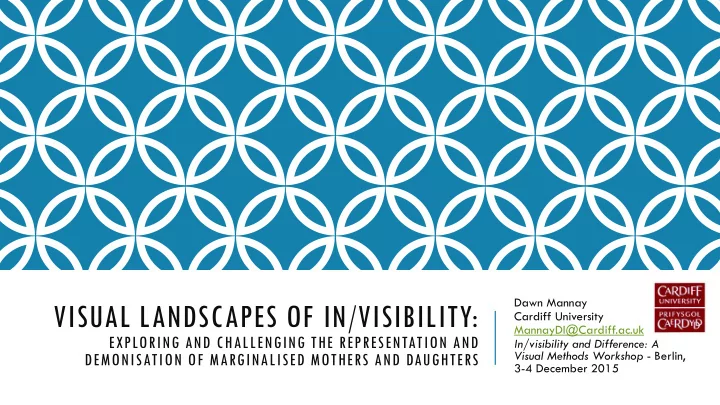

Dawn Mannay VISUAL LANDSCAPES OF IN/VISIBILITY: Cardiff University MannayDI@Cardiff.ac.uk EXPLORING AND CHALLENGING THE REPRESENTATION AND In/visibility and Difference: A Visual Methods Workshop - Berlin, DEMONISATION OF MARGINALISED MOTHERS AND DAUGHTERS 3-4 December 2015
INTRODUCTION Silenced voices Speaking back Being seen Visibility and Invisibility Impact and/or protection Ethics, practicalities and time immemorial Reflections on projects with marginalised communities
THE OBJECTIFYING GAZE 19 th Century Photographic methods Analyses and represent ‘other’ cultures Embedded in power relations Imperialism Photography became part of the objectifying gaze of the colonial project
THE COLONIAL PROJECT Reductive realism Regulatory system Hierarchical ordering of race Pseudo-science Authorative evidence
A PICTURE HELD US CAPTIVE… Photograph is a construction of culture Truthfulness of the appearance of things The indignity of speaking for others
REPRESENTATIONS OF MOTHERHOOD Morant (1998) ‘ motherhood is objectified as a young, feminine woman. She seems to have the stereotypical rosy glow of motherhood and looks calm and contemplative… work to define what forms of femininity are socially acceptable and desirable. But at the same time they also render invisible [other] women
‘OTHER’ MOTHERS Figures are brought to life and endowed with affect through mediation This figure of chav mum circulates within a wide range of media, celebrity media, reality television, print media, literature, news media, films, and “chav hate” websites. Through the figure of chav a new publicly sanctioned wave of middle-class contempt for the lower classes is bodied forth Impacts on public perceptions and social policy (Tyler 2008) (Mannay, Grant and Mason – current project)
SILENCED VOICES The ability to create written, visual and printed records depends on a number of social, political and economic factors Tight binds between literacy, archives and authority in making of history Visual cultures are dominated by power Women’s invisibility and stigmatising high visibility
VISUAL VOICES ‘I quilt because I don’t want my history, my story to die. Quilting gives me a voice when I can’t write or speak’ (Goggin 2003) Arpilleras - Pinochet's Chile – Roberta Bacic
‘OTHER’ MOTHERS SPEAKING BACK (BRADY AND BROWN 2013) – BUT TIME IMMEMORIAL? OPEN ACCESS? PRESENTATION COPY - IMAGE REMOVED
‘ETHICS OF RECOGNITION’ Preoccupation with anonymity acts as resistance to discourses of participant visibility (Sweetman) Sensitive topics - domestics abuse, abortion, violence, divorce Images cannot speak – whose voice? How can images be disguised ethically?
INFORMED? CONSENT AND UNKNOWING OTHERS Participants can only consent for themselves Is the consent informed? Do they understand how there data will be used – what is a conference, journal article? Open Access? (Mannay 2014) What about unknowing others? (Mannay 2011)
VISUAL OPPORTUNITIES, DEFAMILIARISATION, IN/VISIBILITIES
VISUAL RE-REPRESENTATIONS
SUMMARY The visual offers a range of exciting possibilities for social research but it also brings an array of challenges and ethical difficulties Visual and creative researchers themselves need to remain ardent critics of the research process, to be aware of the possible difficulties, and to continue to explore landscapes of representation, interpretation, voice, trust, confidentiality, silence; and the intended and unintended consequences of research with narratives and visual images. It is also useful to consider the ways in which creative narrative forms can replace visual images and detailed, identifying, biographical accounts, yet still retain impact; and ethically, yet powerfully, communicate the stories that participants have shared in the research process (Mannay 2015).
REFERENCES Bacic, R. 2013. ‘Arpilleras: Evolution and Revolution’ Keynote Paper and Exhibition, 3 rd International Visual Methods Conference, Victoria University of Wellington, Wellington, New Zealand, 2 – 6 September Berlin Declaration on Open Access to Knowledge in the Sciences and Humanities 2003. Berlin 22 October 2003. Brady, G. and Brown, G. 2013. Rewarding but let’s talk about the challenges: using arts based methods in research with young mothers. Methodological Innovations Online, 8(1), pp. 99-112. Goggin, D. (2003) ‘Introduction’, in C. McEwan, ‘Building a postcolonial archive? Gender, Collective Memory and Citizenship in Post- Apartheid South Africa’, Journal of Southern African Studies, 29 (3): 748. Mannay, D. 2010. Making the familiar strange: Can visual research methods render the familiar setting more perceptible? Qualitative Research, 10 (1), pp. 91-111. Mannay, D. 2011. Taking refuge in the branches of a guava tree: the difficulty of retaining consenting and non-consenting participants ’ confidentiality as an indigenous researcher. Qualitative Inquiry 17(10), pp. 962-964. Mannay, D. 2013. 'I like rough pubs': exploring places of safety and danger in violent and abusive relationships. Families, Relationships and Societies 2(1), pp. 131-137. Mannay, D. 2014. Story telling beyond the academy: exploring roles, responsibilities and regulations in the Open Access dissemination of research outputs and visual data. The Journal of Corporate Citizenship 54, pp. 109-116. Mannay, D. 2015. Visual, narrative and creative research methods: application, reflection and ethics. London: Routledge. Mannay, D. et al. 2015. Understanding the educational experiences and opinions, attainment, achievement and aspirations of looked after children in Wales. Project Report. [Online]. Cardiff: Welsh Government. Available at: http://gov.wales/statistics-and-research/understanding-educational-experiences-opinions-attainment-achievement-aspirations-looked-after-children-wales/?lang=en - Related Film, Art and Music Outputs Available at - http://sites.cardiff.ac.uk/cascade/looked-after-children-and-education/ Morant, N. 1998. ‘Social Representations of Gender in the Media’, in D. Miell and M. Wetherell (eds) Doing Social Psychology, pp. 234 – 83. London: Sage. Sweetman, P. 2009. ‘Just Anybody? Images, Ethics and Recognition’, in John Gillett (ed .) Just Anybody. Renja Leino, pp. 7 – 9. Winchester: Fotonet/The Winchester Gallery. Tyler, I. 2008. ‘Chav Mum Chav Scum’, Feminist Media Studies , 8 (1): 17 – 34.
Recommend
More recommend